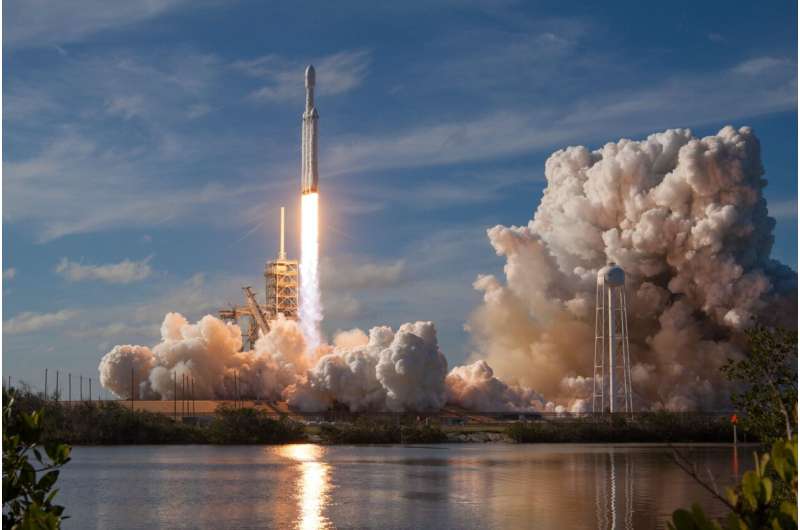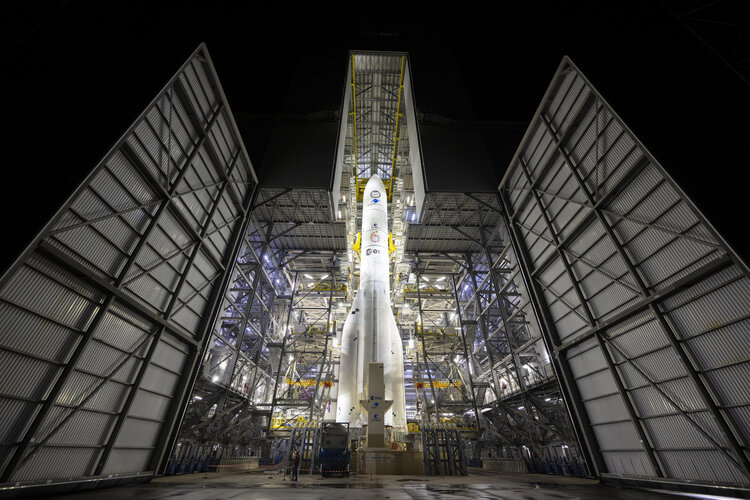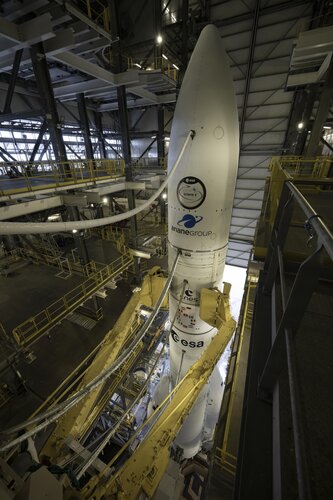Ariane 6 revealed as nine-story mobile building rolls back from the launch pad
Tuesday, 09 July 2024 12:00 Image:
Ariane 6 revealed as nine-story mobile building rolls back from the launch pad
Image:
Ariane 6 revealed as nine-story mobile building rolls back from the launch pad Russia’s nuclear threat to space is worse than a “Cuban Missile Crisis in space”
Tuesday, 09 July 2024 12:00
SpaceX sends up Space Coast's 50th rocket launch of the year
Tuesday, 09 July 2024 10:23
SpaceX continued the Space Coast's record rocket launch pace with a July 8 evening liftoff from Cape Canaveral, Florida.
A Falcon 9 rocket on the Turksat-6A mission carrying a Turkish communications satellite to a geosynchronous transfer orbit lifted off from Cape Canaveral Space Force Station's Space Launch Complex 40 at 7:30 p.m. Eastern time.
This was the 15th flight of the first-stage booster, which made a recovery landing downrange on the droneship Just Read the Instructions stationed in the Atlantic.
It was the 50th launch of the year from either Canaveral or neighboring Kennedy Space Center, with SpaceX responsible for 47 of them.
The other three have been from United Launch Alliance during a year that could see more than 100 missions fly for the first time, besting 2023's record of 72 launches.
Both SpaceX and ULA have more launch plans for later this month, including SpaceX's next Starlink launch, slated for July 12. ULA is targeting no earlier than July 30 for an Atlas V mission on the USSF-51 mission for the Space Force, while SpaceX is prepping for the return of billionaire Jared Isaacman to space on the Polaris Dawn mission no earlier than July 31.
House spending bill directs NASA to study asteroid and orbital debris missions
Tuesday, 09 July 2024 05:54

SpaceX launches Turkey’s first home-grown communications satellite
Tuesday, 09 July 2024 00:22

Ariane 6 the day of launch
Monday, 08 July 2024 23:18 Image:
Ariane 6 the day of launch
Image:
Ariane 6 the day of launch Ariane 6 the day before launch
Monday, 08 July 2024 23:18 Image:
Ariane 6 the day before launch
Image:
Ariane 6 the day before launch Private companies key players in China's space development
Monday, 08 July 2024 20:22 The trial of Tianlong 3 a two-stage kerosene-liquid oxygen rocket developed by Beijing Tianbing Technology failed in Gongyi, Henan province, on Sunday. The company apologized on Tuesday for the accident.
Most private space enterprises were founded after November 2014, when the State Council started encouraging private capital to participate in space infrastructure construction for civil us
The trial of Tianlong 3 a two-stage kerosene-liquid oxygen rocket developed by Beijing Tianbing Technology failed in Gongyi, Henan province, on Sunday. The company apologized on Tuesday for the accident.
Most private space enterprises were founded after November 2014, when the State Council started encouraging private capital to participate in space infrastructure construction for civil us Search for extraterrestrial life focuses on detecting exoplanet atmospheres
Monday, 08 July 2024 20:22 Examining atmospheres around planets beyond our solar system is a crucial step in the search for extraterrestrial life. Astronomist Sebastian Zieba, using data from the James Webb Space Telescope, has been studying small rocky exoplanets. Although no signs of life have been detected yet, his research remains significant for future studies. Zieba graduated cum laude on 25 June.
"The holy gr
Examining atmospheres around planets beyond our solar system is a crucial step in the search for extraterrestrial life. Astronomist Sebastian Zieba, using data from the James Webb Space Telescope, has been studying small rocky exoplanets. Although no signs of life have been detected yet, his research remains significant for future studies. Zieba graduated cum laude on 25 June.
"The holy gr Tiny bright objects discovered at dawn of universe baffle scientists
Monday, 08 July 2024 20:22 A recent discovery by NASA's James Webb Space Telescope (JWST) confirmed that luminous, very red objects previously detected in the early universe upend conventional thinking about the origins and evolution of galaxies and their supermassive black holes.
An international team, led by Penn State researchers, using the NIRSpec instrument aboard JWST as part of the RUBIES survey identified th
A recent discovery by NASA's James Webb Space Telescope (JWST) confirmed that luminous, very red objects previously detected in the early universe upend conventional thinking about the origins and evolution of galaxies and their supermassive black holes.
An international team, led by Penn State researchers, using the NIRSpec instrument aboard JWST as part of the RUBIES survey identified th NASA Shares Use Requirements With Commercial Destination Partners
Monday, 08 July 2024 20:22 the space agency hosted a meeting to share knowledge with companies developing future commercial destinations at the agencys Johnson Space Center in Houston. The discussion could aid in developing safe, reliable, innovative, and cost-effective space stations. Industry representatives from more than 20 companies attended.
The program focused on the space agencys planned use of commercial de
the space agency hosted a meeting to share knowledge with companies developing future commercial destinations at the agencys Johnson Space Center in Houston. The discussion could aid in developing safe, reliable, innovative, and cost-effective space stations. Industry representatives from more than 20 companies attended.
The program focused on the space agencys planned use of commercial de UArizona's first satellite built by students is ready for launch
Monday, 08 July 2024 20:22 The sun barely peeks over the horizon as a suitcase-like transport box exits Steward Observatory, home to the University of Arizona Department of Astronomy. Inside, held snugly in place by foam, is precious cargo: CatSat, the university's first satellite built entirely by students.
After loading it into the back of the car, Shae Henley and Walter Rahmer, both engineering students at UArizo
The sun barely peeks over the horizon as a suitcase-like transport box exits Steward Observatory, home to the University of Arizona Department of Astronomy. Inside, held snugly in place by foam, is precious cargo: CatSat, the university's first satellite built entirely by students.
After loading it into the back of the car, Shae Henley and Walter Rahmer, both engineering students at UArizo Discovering Milan: A Comprehensive Guide to Exploring the Milan Cathedral and Beyond
Monday, 08 July 2024 20:22 Milan, Italy's fashion and financial capital, is a city that effortlessly combines history, culture, and modernity. From its stunning architecture to its world-renowned shopping districts, Milan offers a plethora of experiences for every traveler. At the heart of this bustling metropolis lies the Milan Cathedral, or Duomo di Milano, an architectural marvel that has captivated visitors for cen
Milan, Italy's fashion and financial capital, is a city that effortlessly combines history, culture, and modernity. From its stunning architecture to its world-renowned shopping districts, Milan offers a plethora of experiences for every traveler. At the heart of this bustling metropolis lies the Milan Cathedral, or Duomo di Milano, an architectural marvel that has captivated visitors for cen Scientists reveal the density differences of sub-Neptunes due to resonance
Monday, 08 July 2024 20:22 The majority of stars in our galaxy host planets, with sub-Neptunes, which are planets sized between Earth and Neptune, being the most common. Estimating their density has been a significant challenge for scientists because the method used to measure their mass highlights two distinct populations: dense and less dense. Recent work by the NCCR PlanetS, the University of Geneva (UNIGE), and the Un
The majority of stars in our galaxy host planets, with sub-Neptunes, which are planets sized between Earth and Neptune, being the most common. Estimating their density has been a significant challenge for scientists because the method used to measure their mass highlights two distinct populations: dense and less dense. Recent work by the NCCR PlanetS, the University of Geneva (UNIGE), and the Un Cosmic Shielding protects Nvidia Ai hardware in upcoming Spacex launch
Monday, 08 July 2024 20:22 Cosmic Shielding Corporation (CSC), providers of the worlds leading space radiation shielding technologies, will be utilized to develop an AI-capable space computer that uses the Nvidia Jetson Orin NX GPU. This will mark the first time a GPU from the latest Nvidia Orin ecosystem has been sent to space and will be part of the SpaceX Falcon 9 rocket launch from Vandenberg Space Force Base, Califor
Cosmic Shielding Corporation (CSC), providers of the worlds leading space radiation shielding technologies, will be utilized to develop an AI-capable space computer that uses the Nvidia Jetson Orin NX GPU. This will mark the first time a GPU from the latest Nvidia Orin ecosystem has been sent to space and will be part of the SpaceX Falcon 9 rocket launch from Vandenberg Space Force Base, Califor 
